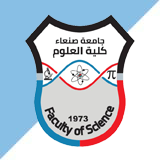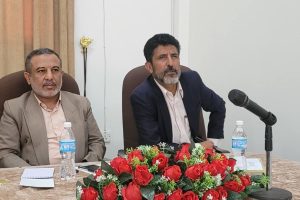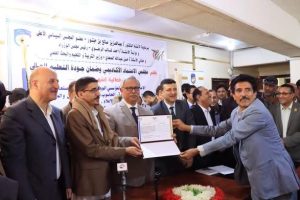Public discussion of the doctoral thesis submitted by researcher Rania Ali Saleh Al-Ali, College of Science, Sana’a University
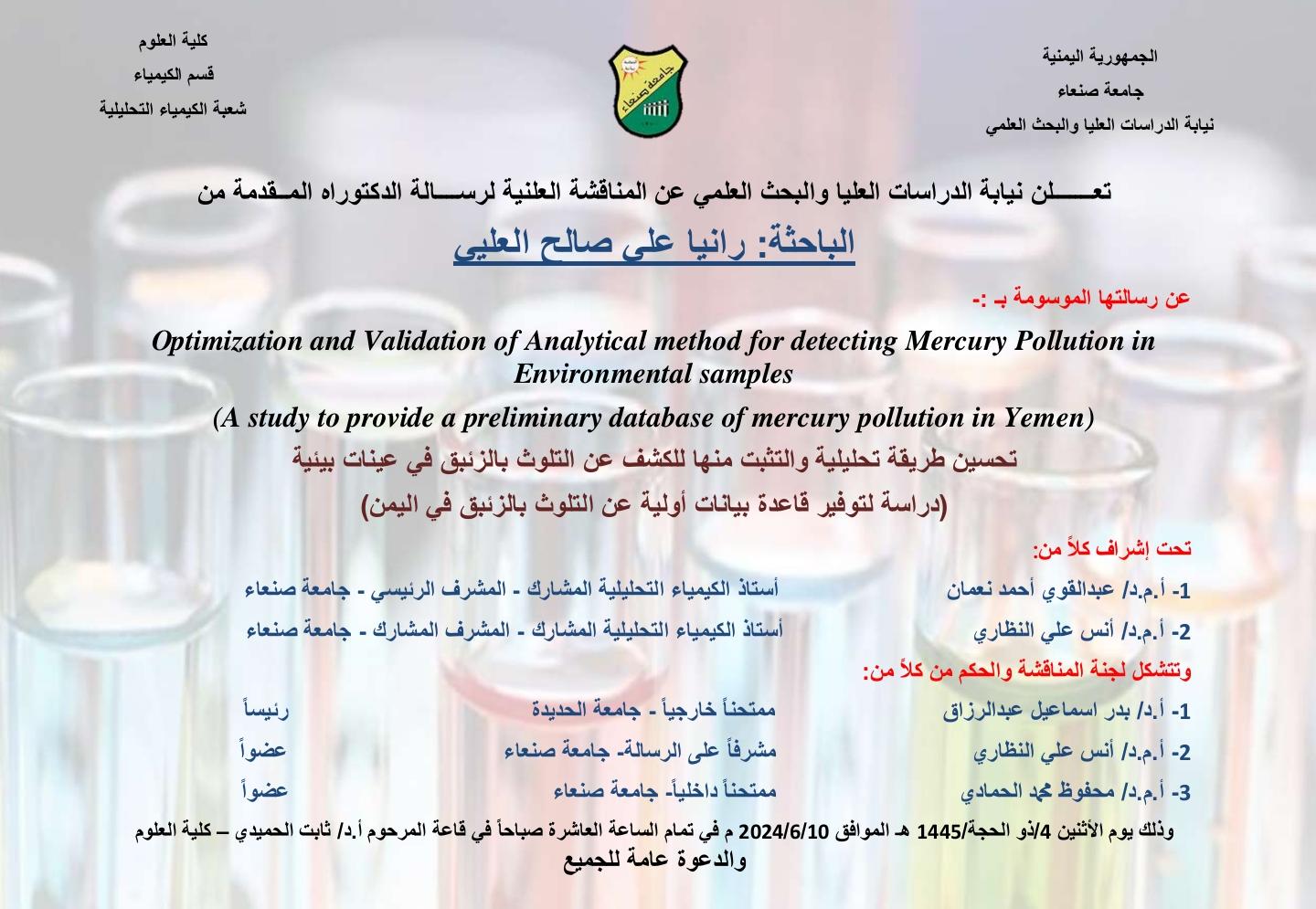
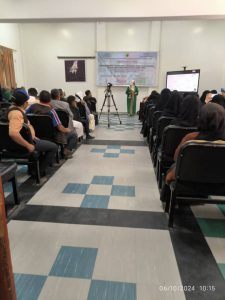
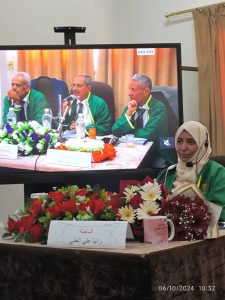
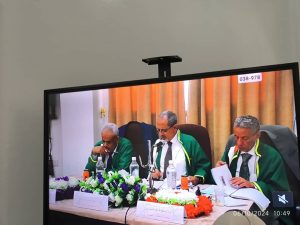
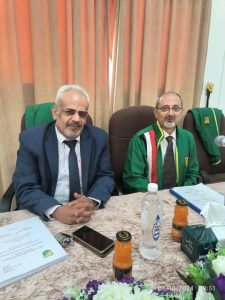
SAMMARY
Mercury contamination represents a significant challenge for global health and the environment, as the international community has issued many laws and legislation, these legal frameworks, such as the Stockholm Convention and the Minamata Convention, require participating nations to implement effective strategies to reduce mercury pollution. The fact that Yemen is one of the signatory countries to this agreement results in an inventory sources of mercury pollution in Yemen. In addition to the fact that mercury is considered one of the dangerous chemicals that cross countries, and according to the information available to us, there is no scientific study that constitutes a database on mercury pollution to be consulted, exceptionally, some reports are available with the General Authority for Environmental Protection, which is affiliated with the Ministry of Water and Environment, or some limited studies about a specific number of fish samples over long periods of time. However, they did not cover all Yemeni beaches that cannot be relied upon as a database. This scientific gap must be studied to provide a database for mercury pollution in Yemen.
This study aimed to optimize and validate an analytical method for detecting mercury contamination in some environmental samples. This is the first national study to provide a preliminary database for mercury contamination in Yemen for the greatest diversity of mercury pollution sources three groups in some fish samples, locally canned tuna, and well water samples.
The thesis was divided into five main chapters as follows:
Chapter One:
This chapter includes basic information about mercury, its properties, sources, and the life cycle of mercury. It also highlights the main analytical techniques used to estimate mercury, such as gas chromatography, atomic absorption spectroscopy, etc.
Chapter Two:
In this chapter, published literatures were reviewed to highlight the efforts of the scientific community to face the challenges in estimating mercury in some environmental samples, including fish samples, canned tuna, well water, soil, blood, and cosmetics samples. This chapter also indicates the objectives of this thesis.
Chapter Three:
This chapter presents the methodology used in this study, the sources of chemicals, reagents and devices used, the procedures followed to collect the various samples under study, the preparation of standard solutions, the procedures for verifying the devices and analytical methods, and finally, the quality control procedures followed in the analysis.
Chapter Four:
This chapter presented the results and discussion of the study of and hence divided into four main parts:
Part One: This part, included they validation of the inductively coupled plasma optical emission spectroscopy (ICP-OES) and the direct mercury analyzer (DMA) and the results were as follows:
This section described the validation of ICP-OES, showing high precision as the values of the relative standard deviation were less than 8%, High linearity was occurred with the correlation coefficient of 0.9996. The values of the limit of detection and the limit of quantification were found to be 0.00083 and 0.00274 ppm, respectively. The method was verified by spiked fish samples with different concentrations of standard mercury solution, ranging from 0.02 to 1 ppm. The results indicated the high precision of the method, as the values of the relative standard deviation ranged from 4.98% to 12.66%. The recovery ranged from 87.38% to 118.85%, and the values of the detection and quantification limits were found to be 0.0673 and 0.2221 ppm, respectively.
For DMA at low to mid mode, the validation results showed that the device has high precision, as the values of the relative standard deviation were less than 3%, and high linearity, with a correlation coefficient value of 0.9974. The values of the detection and quantification limits were of 0.0015 and 0.0049 ppm, respectively. The validation method was confirmed by spiked fish samples with various amounts of standard mercury solutions, ranging from 2 to 100 ng. The results showed that the method had high precision, expressed in terms of the relative standard deviation values of 1.34% – 5.62%. The recovery ranged between 96.77% and 105.14% and the values of the detection and quantification limits, for the method were 0.0015 and 0.0049 ppm, respectively.
When comparing the validation results of the method using both the DMA and ICP-OES, the results showed a higher level of precision as well as a higher sensitivity using the DMA with twenty times greater than the analysis method. The reason for this is primarily due to the sample preparation process, as leads to dilution of the sample in the ICP-OES, which may lead to reducing the sensitivity of the method. Moreover, the analysis using the direct mercury analyzer is highly efficient and quick, as the analysis time ranged from 6 to 8 minutes without the need to consume time preparing samples. Accordingly, this method has proven to be cost-effective because it eliminates the need to consume solvents, making it environmentally sustainable, direct, and economical.
Part Two: This part includes applying the verified method for analyzing total mercury in 240 fish samples collected from many fish landing centers in Yemen along the coasts of the Red Sea, the Arabian Sea, and the Gulf of Aden.
The results indicated that the mercury levels in 227 samples were within the limits set and permitted by the European Union (EU Commission) and the Yemeni Organization for Standardization, Metrology and Quality Control (YSMO). Ten samples were exceeded the permissible limits for mercury concentrations greater than 0.5 and less than 1ppm and three samples had mercury concentrations higher than one ppm, which is the permissible limit for large fish according to the European Union Commission.
Part Three: This section showed the validation results of the analysis method using DMA at a low to mid mode, where the results of the method showed high precision the relative standard deviation as values were less than 5%. High linearity was occurred, with a correlation coefficient of 0.9993. Local canned tuna samples were also spiked using an amounts of standard mercury solution that ranged from 1 to 40 nanograms. The results proved that the analytical method was highly precision, as the values of the relative standard deviation were from 1.05% to 4.45%, and the recovery ranged from 96.61% to 100.49%, which proves the high accuracy of the analysis method. The values of detection and quantification limits were found to be 0.00162 and 0.0045 ppm, respectively, which reflects the high sensitivity of the method. This analytical method was applied to estimate total mercury in 31 samples of locally canned tuna collected from local markets Sana’a city. The results showed that the concentration of mercury in all tuna samples under investigation is within the permissible limits set by the Yemeni Organization for Standardization, Metrology and Quality Control (YSMO), which is 0.5 parts per million.
Part Four: It included validation of DMA and mercury analysis method in well water samples collected from Sana’a city.
The validation results of the device for DMA at Ultra-mode showed that the values of the relative standard deviation were less than 5%. High linearity was occurred with correlation coefficient of 0.9940. The values of the detection and quantification limits were found to be 0.0910 and 0.3110 ppb, respectively. Moreover, the method was verified by spiked well water samples with different concentrations of standard mercury solution, ranging from 0.2 to 20 ppb. The results showed the high precision of the method, as is evident from the values of the relative standard deviation, which ranges from 1.73% to 8.38%, the recovery percent values ranged from 92.23% to 108.90%, and the detection and quantification limits were found to be 0.0910 and 0.3110 ppb, respectively. After that, the confirmed method was applied to estimate mercury in 58 samples collected from Sana’a city. The results of the analysis indicated that the concentration of mercury in all samples was within the permissible limits set by the world health organization (WHO) and the (YSMO), which is one part per billion.
Chapter Five:
This chapter includes the most prominent conclusions reached by this study and recommendations.
